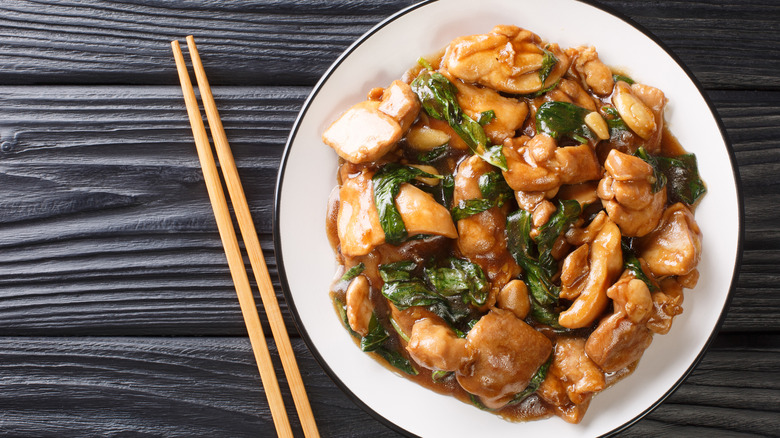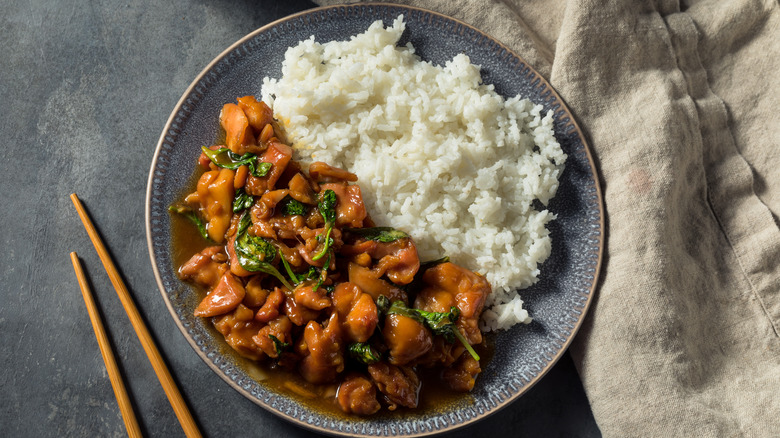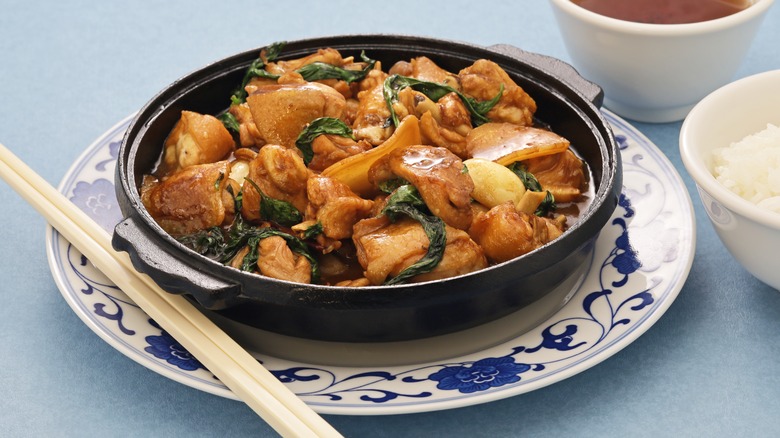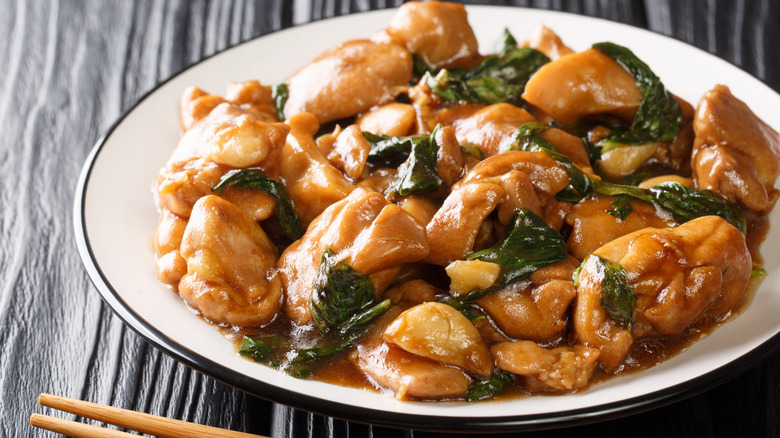What Makes Taiwanese Three Cup Chicken Unique
If you love chicken, you've probably eaten it in various ways, from fried to braised to poached and beyond. It's an incredibly versatile protein that's beloved all over the world, and it shows up in countless famous Asian dishes. Think, for example, of Chinese General Tso's chicken, little nuggets of crispy fried chicken that are tossed in a tangy glaze and topped with sesame seeds, Vietnamese chicken pho, a fragrant soup imbued with ginger and spices and loaded with springy rice noodles, and Indonesian chicken satay, skewers of chicken marinated in lemongrass, garlic, and ginger that are grilled over charcoal (via Saveur).
These chicken dishes have traveled far beyond their countries of origin to dinner tables all over the globe, and so too has Taiwan's iconic chicken dish, three cup chicken. A centuries-old dish of chicken pieces glazed in a soy-rich sauce, according to The New York Times, three cup chicken takes its name from the ratio of ingredients that was once used to create the recipe.
Where does the name three cup chicken come from?
If you've ever made pound cake at home, you probably know that the classic dessert takes its name right from its ingredients list, originally calling for a pound each of butter, sugar, eggs, and flour, according to What's Cooking America. Over time, these enormous cakes got scaled back to feed just a few people, but the proportion of the ingredients remain the same.
That same idea is how three cup chicken got its name, according to The Woks of Life. Originally, as the story goes, the dish called for equal parts of sesame oil, rice wine, and soy sauce — a cup of each. But because those quantities would result in a super-oily and overly acidic result, they have been reduced over time. "If you actually cook it that way," Taiwanese-American restaurateur Eddie Huang told the Times, referring to the dish's original formula, "you'll be in trouble. The point is to draw the sugar out of all the ingredients using a little sesame oil, but not a lot."
History of three cup chicken
According to The New York Times, this Taiwanese dish has roots in mainland China. Three cup chicken is often traced back to the 13th century, to the execution of Wen Tianxiang. A writer, philosopher, and politician who lived during the Song Dynasty, from 1226 to 1283, Wen Tianxiang led an armed resistance to Mongol Kublai Khan's invasion of the Song Dynasty, and was eventually captured, tortured, and executed by the incoming Yuan Dynasty (via Google Arts & Culture). Regarded as a Chinese nationalist hero, Wen Tianxiang was supposedly served an improvised version of the dish as his last meal, after a prison guard threw the chicken together. Over the centuries, as large numbers of people emigrated from mainland China to settle in Taiwan (via My China Roots), three cup chicken traveled with them, becoming firmly established as a Taiwanese specialty. "It's a seminal dish," Huang told the Times.
How to make three cup chicken
Three cup chicken is a dish that's pretty easy to make at home, which is probably why it's traveled with Taiwanese as they have settled all over the world, according to The New York Times. The three cup ratio in the recipe's name has long been discarded, but the trifecta of sesame oil, rice wine, and soy sauce remains the dish's signature flavor. The exact ratio, however, as well as the quantities of other ingredients such as basil, ginger, and garlic, change from cook to cook.
"No two households make three cup chicken the exact same way," Chinese American blogger Kaitlin Leung writes on The Woks of Life, "but the basic recipe uses those three sauce ingredients to create a thick, dark, reduced syrup that absorbs right into the chicken." Leung's recipe calls for pieces of chicken wings and drums to be heavily seared in a mix of sesame and vegetable oil heated with sliced ginger, sliced garlic, and a dried chile. Then, ¼ cup of Shaoxing rice wine, a 7 tablespoon mix of light and dark soy sauce and 2 teaspoons of sugar are added to the wok, and the chicken simmers in the sauce until it is reduced to a dark glaze. Finally, the dish is finished with handfuls of Thai basil and sliced scallions. Both Serious Eats and The New York Times, whose recipes for the dish are similar, call for serving it with hot white rice.



